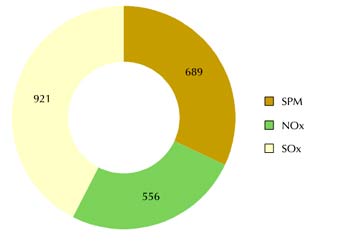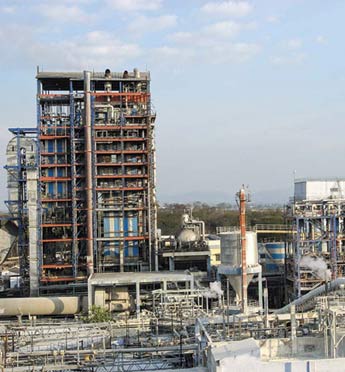|
Reducing Significant Emissions |
ITC in its endeavour to reduce significant emissions has established adequate controls
and regular monitoring of air emissions such as Suspended Particulate Matter (SPM), Oxides
of Sulphur (SOx) and Oxides of Nitrogen (NOx) in all its units. In addition, emission of
Hydrogen Sulphide (H2S) is monitored at the Bhadrachalam paper mill on a
regular basis. The measured parameters are regularly communicated to the respective
Pollution Control Boards. During 2004-05, the monitored air emissions were as follows:
Significant Air Emissions by ITC units in 2004-05 (tonnes)

The Paperboards and Specialty Papers business accounted for more than 50% of the total
emissions reported. The Bhadrachalam paperboards unit emitted 4.6 tonnes of H2S.
ITC’s Cigarettes business emitted 2.65 kg of SPM/million cigarettes produced. The
specific emission levels of Sulphur Dioxide (SO2) and NOx were at 3.94 kg and
1.50 kg/million cigarettes manufactured, respectively.
|
Ozone Depleting Substances (ODS) |
As one of the signatories to the Montreal Protocol, India has formulated a policy
phasing out Ozone Depleting Substances. In line with Government of India requirements, ITC
has developed programmes to meet the requirements well before the deadlines stipulated by
the Government. All ITC units focus on reducing the consumption of ODS through effective
preventive maintenance schedules, and replacement of old equipment with latest non-ODS
technology. These are audited regularly by the Corporate EHS to ensure compliance. In the
year 2004-05, all the units of ITC had 4.11 tonnes of ODS (equivalent to CFC-11) in use. |
 |
|
Bhadrachalam Paperboards Unit |
In 2004-05, the mill generated 1.42 kg of SPM/Bone-Dry Metric Tonne (BDMT) of
paperboard produced, which compares well with the specific SPM emission levels of Indian
Papermills (reported in the range of 1.1 kg/BDMT to 11 kg/BDMT). The specific emission
level of SO2 for the unit was monitored at 0.57 kg/tonne of paperboard, whereas
the European Union pulp and paper mills have specific emissions of 0.7 kg/tonne of
product. The specific NOx emission level was at 0.76 kg/tonne of paperboard. This compares
well with 1.14 kg of NOx generation per tonne of product in the European pulp and paper
industry (Source: Green Rating Project by Centre for Science and Environment, 2004).

Except the two newly opened hotels in Mumbai and Kolkata, all other units of ITC have
been in operation for several years. ITC Grand Central Sheraton in Mumbai is actually
built on the land vacated by one of ITC’s cigarette factories. Even though both the
hotels are situated in dense urban locations, Environmental Impact Assessment (EIA) was
fully carried out to address impact, if any, on biodiversity, affecting species and
ecosystems. |